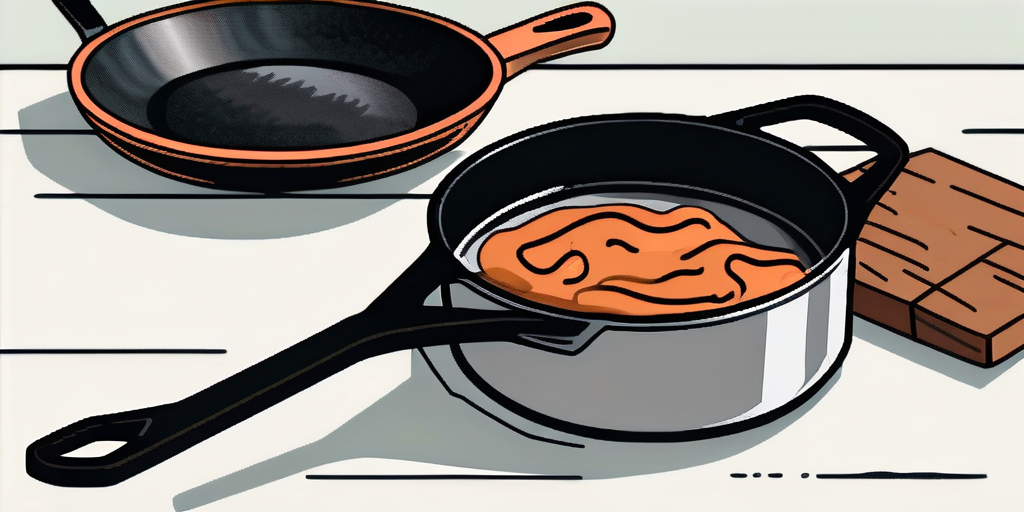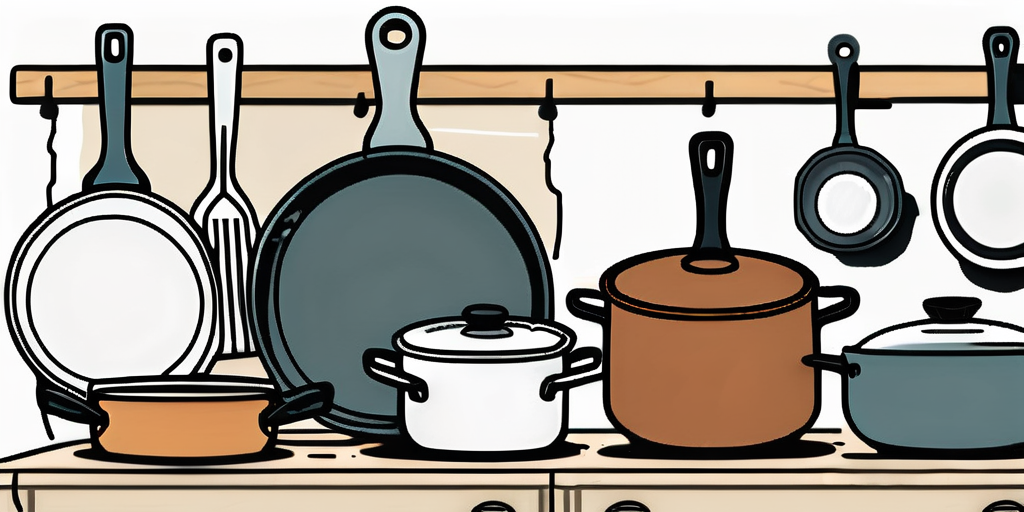When it comes to cooking, the material of the cookware you use plays a crucial role in the quality of your dishes. From enhancing flavors to affecting cooking techniques, choosing the right materials can make a significant difference in your culinary creations. In this comprehensive guide, we will explore the importance of quality materials in cooking and provide you with practical tips on how to select the best cookware for your needs.
Understanding the Importance of Quality Materials in Cooking
Quality materials in cookware not only contribute to the taste and nutritional value of your food but also impact your overall cooking experience. Let's delve into the two essential aspects affected by the choice of cooking materials.

The Role of Material in Flavor and Nutrition
The material of your cookware can influence the flavors and nutrients of your dishes. Certain materials, such as copper and cast iron, possess excellent heat conductivity, ensuring even distribution of heat. This allows for better caramelization and browning, enhancing the taste and texture of your food. On the other hand, reactive materials like aluminum can affect the taste and appearance of acidic foods, potentially altering their flavors.
Furthermore, the choice of material can impact the nutritional value of your meals. Non-reactive materials like stainless steel and glass maintain the integrity of flavors and preserve the nutritional value of your ingredients. This means that when you cook with these materials, you can be confident that your food retains its essential vitamins and minerals, providing you with a healthy and nourishing meal.
When selecting cookware, it is crucial to consider the flavors and nutrients you aim to achieve. Choosing the right material that aligns with your culinary goals is essential for creating delicious and nutritious dishes.
How Material Affects Cooking Techniques
The material of your cookware also influences your cooking techniques. Different materials have varying heat retention properties, which can affect the cooking time and temperature control of your dishes.
For example, cast iron retains heat for a longer duration, making it ideal for slow cooking and braising. Its ability to distribute heat evenly ensures that your food cooks thoroughly and develops rich flavors. On the other hand, stainless steel heats up quickly and provides precise temperature control, making it suitable for sautéing and searing. This allows you to achieve the perfect sear on a steak or quickly sauté vegetables without compromising their texture.
Understanding how materials affect cooking techniques allows you to choose cookware that aligns with your preferred cooking methods and helps you achieve optimal results. Whether you enjoy slow-cooked stews or quick stir-fries, selecting the right material can enhance your cooking experience and elevate the flavors of your dishes.
Types of Materials Used in Cooking
Now that we have established the significance of materials in cooking, let's explore the different types of materials commonly used in cookware:
Overview of Common Cooking Materials
1. Stainless Steel: Stainless steel is a popular choice due to its durability, non-reactive nature, and resistance to rust and corrosion. It provides excellent heat retention and is suitable for a wide range of cooking techniques.
When it comes to stainless steel cookware, there are different grades available. The most common ones are 18/8 and 18/10, which refer to the percentages of chromium and nickel in the steel. The higher the nickel content, the more resistant the cookware is to corrosion and staining. Stainless steel pans often have an aluminum or copper core in the base to improve heat distribution.
2. Cast Iron: Cast iron is renowned for its exceptional heat retention and even heat distribution. It is ideal for slow cooking, searing, and baking. Proper seasoning and maintenance are essential to prevent rust and maintain its non-stick surface.
Cast iron cookware has been used for centuries and is known for its durability. The seasoning process involves coating the surface with oil and heating it to create a natural non-stick layer. This layer not only prevents food from sticking but also adds flavor to the dishes. With proper care, cast iron cookware can last for generations.
3. Copper: Copper offers unmatched heat conductivity, allowing for precise temperature control. It is often used as a core or lining in combination with other materials due to its reactivity with certain foods.
Copper cookware is highly regarded by professional chefs for its excellent heat distribution. However, pure copper can react with acidic foods, leading to a metallic taste. To overcome this, copper cookware is often lined with stainless steel or tin. The lining provides a non-reactive surface while still benefiting from copper's superior heat conductivity.
4. Aluminum: Aluminum is known for its excellent heat conductivity but can react with acidic foods. It is often used in combination with other materials or coated to prevent reactions.
Aluminum cookware is lightweight and heats up quickly, making it a popular choice for everyday cooking. However, pure aluminum can react with acidic ingredients, causing discoloration and altering the taste of the food. To address this issue, aluminum cookware is often coated with a non-stick layer or anodized to create a protective barrier.
Pros and Cons of Different Materials
1. Stainless Steel:
- Pros: Durable, non-reactive, easy to clean, and versatile.
- Cons: Poor heat conductivity, may require a layered or aluminum-encapsulated base for better heat distribution.
Stainless steel cookware is known for its longevity and resistance to staining and corrosion. It is also dishwasher safe, making cleanup a breeze. However, stainless steel has relatively poor heat conductivity, which can result in uneven cooking. To overcome this, many stainless steel pans have a layered or aluminum-encapsulated base, which improves heat distribution.
2. Cast Iron:
- Pros: Excellent heat retention and even heat distribution, versatile, ideal for slow cooking.
- Cons: Requires proper seasoning and maintenance to prevent rust, heavy and bulky.
Cast iron cookware excels at retaining heat, making it perfect for dishes that require long, slow cooking. Its even heat distribution ensures that food cooks uniformly. However, cast iron requires regular seasoning and proper maintenance to prevent rust. Additionally, cast iron pans are heavy and can be cumbersome to handle.
3. Copper:
- Pros: Exceptional heat conductivity, precise temperature control.
- Cons: Reactive with certain foods, requires regular polishing to maintain appearance.
Copper cookware offers unparalleled heat conductivity, allowing for precise temperature control. This makes it a favorite among professional chefs who require precise cooking techniques. However, copper can react with acidic foods, leading to a metallic taste. Furthermore, copper cookware requires regular polishing to maintain its shiny appearance.
4. Aluminum:
- Pros: Excellent heat conductivity, lightweight.
- Cons: Reactive with acidic foods, may require coating or anodization to prevent reactions.
Aluminum cookware is valued for its superb heat conductivity and lightweight nature, making it easy to handle. It heats up quickly and evenly, ensuring efficient cooking. However, aluminum can react with acidic ingredients, causing discoloration and altering the taste of the food. To mitigate this, aluminum cookware is often coated with a non-stick layer or anodized to create a protective barrier.
Factors to Consider When Choosing Cooking Materials
Now that we have explored the different materials used in cookware, it's essential to consider several factors when selecting the right cooking material for your needs:

Considering Your Cooking Style and Techniques
Assess your preferred cooking style and techniques. Are you a frequent sautéer, baker, or slow cooker enthusiast? Understanding your cooking preferences will help you choose the materials that best align with your needs.
If you enjoy sautéing, you may want to consider materials like stainless steel or cast iron. Stainless steel is known for its excellent heat conductivity and durability, making it ideal for high-temperature cooking methods. On the other hand, cast iron retains heat well and distributes it evenly, making it perfect for searing and browning.
For baking enthusiasts, materials like ceramic or glass may be more suitable. Ceramic cookware provides even heat distribution, ensuring that your baked goods are cooked to perfection. Glass, on the other hand, allows you to monitor the browning and doneness of your baked goods without opening the oven door.
If you are a slow cooker enthusiast, materials like enameled cast iron or stainless steel with an aluminum core are excellent choices. Enameled cast iron retains heat for a long time, making it perfect for slow cooking. Stainless steel with an aluminum core provides excellent heat conductivity and even heat distribution, ensuring that your slow-cooked dishes are cooked evenly.
Evaluating Material Durability and Maintenance
Consider the durability and maintenance requirements of different materials. Some materials may require regular seasoning, polishing, or specific cleaning methods. Assess the level of maintenance you are willing to commit to and choose accordingly.
Stainless steel is known for its durability and resistance to rust and corrosion. It is also relatively easy to clean, requiring only regular washing with soap and water. Cast iron, on the other hand, requires regular seasoning to maintain its non-stick properties and prevent rusting. Seasoning involves applying a thin layer of oil and heating the cookware to create a natural non-stick surface.
Ceramic cookware is known for its non-stick properties and scratch resistance. However, it is essential to handle it with care to avoid chipping or cracking. Glass cookware is also relatively easy to clean but may be prone to breaking if not handled properly.
When it comes to maintenance, enameled cast iron requires minimal effort. It does not require seasoning and can be easily cleaned with soap and water. Stainless steel with an aluminum core may require more maintenance, as it can develop discoloration or stains over time. However, these can usually be removed with specialized stainless steel cleaners.
By considering your cooking style, techniques, and the durability and maintenance requirements of different materials, you can make an informed decision when choosing cooking materials. Remember, selecting the right cookware can greatly enhance your cooking experience and help you achieve delicious results every time!
Tips for Selecting High-Quality Materials
When it comes to selecting high-quality materials for your cookware, it's essential to recognize the signs of quality and know where to purchase reliable products:
Investing in high-quality cookware is crucial for achieving excellent cooking results and ensuring the longevity of your kitchen tools. By selecting the right materials, you can enhance your culinary experience and enjoy the benefits of durable and efficient cookware.
Recognizing Quality in Different Materials
When assessing the quality of cookware materials, there are several key factors to consider:
- Solid Construction: Look for cookware that is well-built and sturdy. High-quality materials should be able to withstand regular use and maintain their shape over time.
- Secure Handles: Handles should be firmly attached to the cookware, providing a comfortable and secure grip. Loose or wobbly handles are indicators of poor craftsmanship.
- Even Thickness: Cookware with even thickness ensures consistent heat distribution, preventing hot spots that can lead to uneven cooking.
- Smooth Finish: A smooth and flawless surface not only enhances the aesthetics of the cookware but also makes it easier to clean and maintain.
By paying attention to these indicators of quality, you can make informed decisions when selecting cookware materials. Additionally, it is beneficial to research reputable brands that are known for their commitment to craftsmanship and use of high-quality materials.
Where to Purchase Quality Cooking Materials
Once you have identified the desired materials for your cookware, it's important to know where to find reliable products:
Kitchenware Stores: Reputable kitchenware stores offer a wide selection of cookware options, allowing you to compare different brands and materials in person. Knowledgeable staff can provide guidance and recommendations based on your specific needs and preferences.
Specialty Cookware Shops: Specialty cookware shops often carry unique and high-quality cookware that may not be readily available elsewhere. These stores cater to cooking enthusiasts and professionals, providing a curated selection of top-notch products.
Online Platforms: The internet has made it convenient to purchase cookware from the comfort of your own home. Online platforms offer a vast array of options, allowing you to explore different brands, materials, and customer reviews. However, it is crucial to choose reputable online retailers that prioritize customer satisfaction and provide clear warranty and return policies.
By considering these purchasing options and conducting thorough research, you can ensure a reliable purchasing experience and find the high-quality cooking materials that meet your needs.
Safety Considerations for Cooking Materials
While choosing the right cookware materials is essential for flavor, nutrition, and cooking techniques, it's also crucial to consider safety aspects:

Potential Health Risks of Certain Materials
Some materials may pose potential health risks when used incorrectly or at high temperatures. For instance, non-stick coatings can release toxic fumes when overheated. Understanding the safe temperature range and limitations of your cookware materials is key to preventing health hazards.
Safe Handling and Use of Cooking Materials
Follow the manufacturer's guidelines for safe handling, use, and maintenance of your cookware. Avoid exposing materials like copper and aluminum to highly acidic or alkaline foods for extended periods and use appropriate utensils to prevent scratching or damaging non-stick surfaces.
In conclusion, choosing good material for your dish is a crucial aspect of creating culinary masterpieces. The choice of materials impacts flavor, nutrition, cooking techniques, and even safety. By understanding the significance of quality materials, considering your cooking style and maintenance preferences, and recognizing signs of quality, you can select cookware that enhances your cooking experience and elevates your dishes to new heights. So, make an informed decision, stock your kitchen with the right materials, and embark on a delicious culinary journey!




